Olight has released the Perun Mini Kit Headlight, which features a very nice (and quite unusual) yellow color! Read on for some testing.
Official Specs and Features
Here’s a shareasale link to the Olight Perun Mini Kit Headlight product page.
Versions
The versions of the Perun Mini are many, but of this specific yellow iteration, there is only the kit or a couple of bundle options.
Price
The kit as seen here sells for $52.46. The other two options sell for $55.19 (with a MCC wall-wart charger) or $64.94 (with Obulb MC).
These are all promotional prices.
Short Review
I like the Olight Perun Mini Kit quite a bit. It’s really unchanged from the orange model I have and already reviewed, but that’s a solid headlamp, too.
Long Review
The Big Table
Olight Perun Mini Kit Headlight Emitter: Osram P9 (CW) Price in USD at publication time: $52.46. Here’s my shareasale link. Cell: 1×16340 Turbo Runtime Graph High Runtime Graph LVP? Yes Switch Type: E-Switch Quiescent Current (mA): 0.8uA On-Board Charging? Yes Charge Port Type: Proprietary Magnetic Charge Graph Power off Charge Port with cell: all modes without cell: no modes Claimed Lumens (lm) 1000 Measured Lumens (at 30s) 1004 (100.4% of claim)^ Candela per Lumen 2.8 Claimed Throw (m) 100 Candela (Calculated) in cd (at 30s) 182lux @ 3.884m = 2746cd Throw (Calculated) (m) 104.8 (104.8% of claim)^ All my Olight reviews!
^ Measurement disclaimer: I am an amateur flashlight reviewer. I don’t have $10,000 or even $1,000 worth of testing equipment. I test output and such in PVC tubes!! Please consider claims within 10% of what I measure to be perfectly reasonable (accurate, even).
What’s Included

- Olight Perun Mini Kit Headlight
- Olight “Customized” 550mAh 16340
- Olight Velcro patch with attachment for flashlight clip
- Lanyard
- Charge cable (USB to proprietary magnetic)
- Lanyard puller
- Headband
- Flashlight hangtag (that’s not a sticker)
- Manual
Package and Manual



Build Quality and Disassembly

The build quality is good as you’d expect. The light feels smooth in hand, and the body provides adequate grip for unscrewing the body.
The head unscrews from the body – and that’s the extent of the parts.
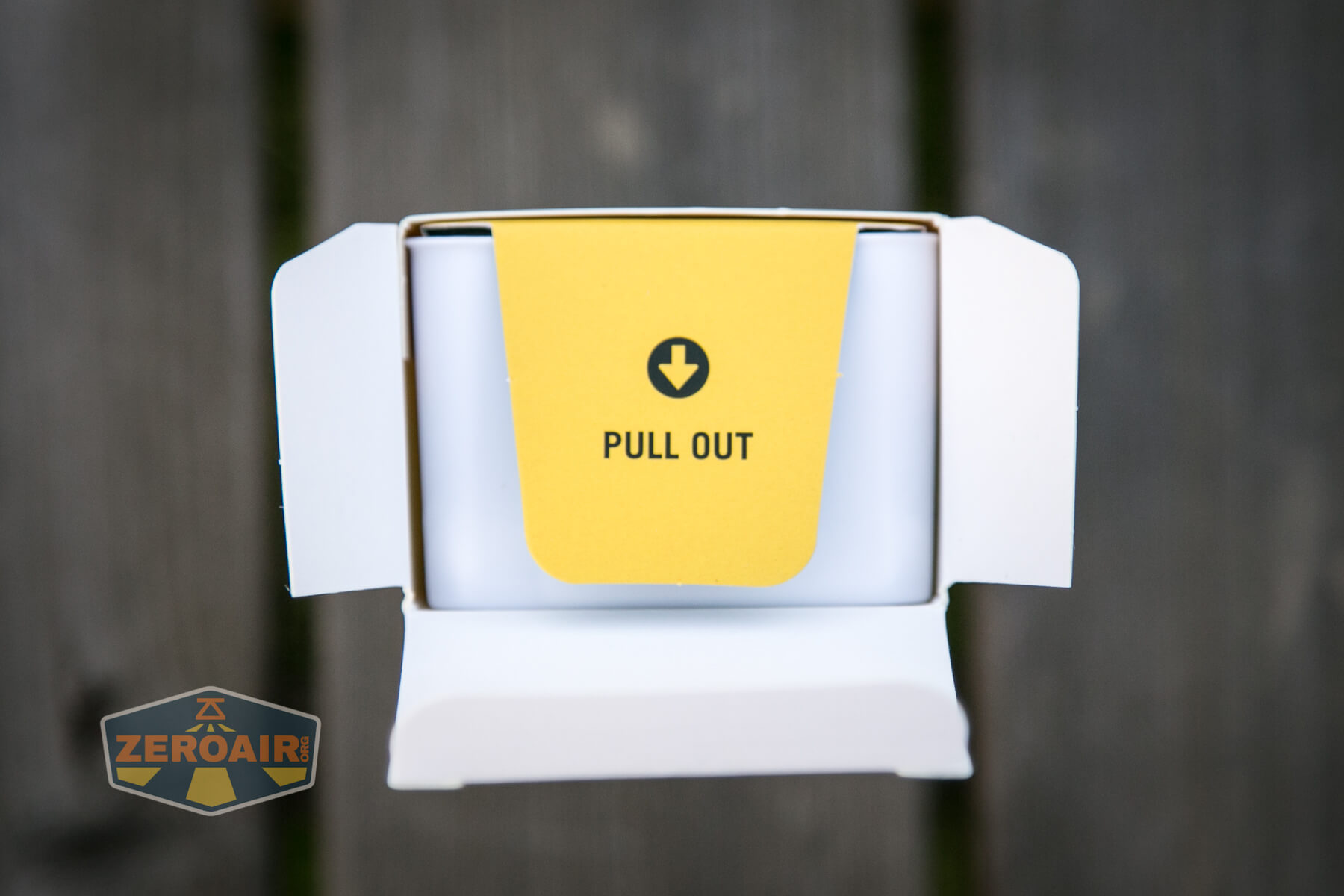

The head end has a short spring and a rubber gasket. That gasket more or less prevents the cell from being installed incorrectly. The tail end does not have a spring but has multiple contact points for the positive end of the cell.

The threads are short, anodized, and square-cut. Short threads are kind of nice, because you’re fighting against the pocket clip to get the body back on to the head.
Size and Comps
Officially:
61.5mm x 21mm and 52g (cell included!).
If the flashlight will headstand, I’ll show it here (usually the third photo). If the flashlight will tailstand, I’ll show that here, too (usually the fourth photo).
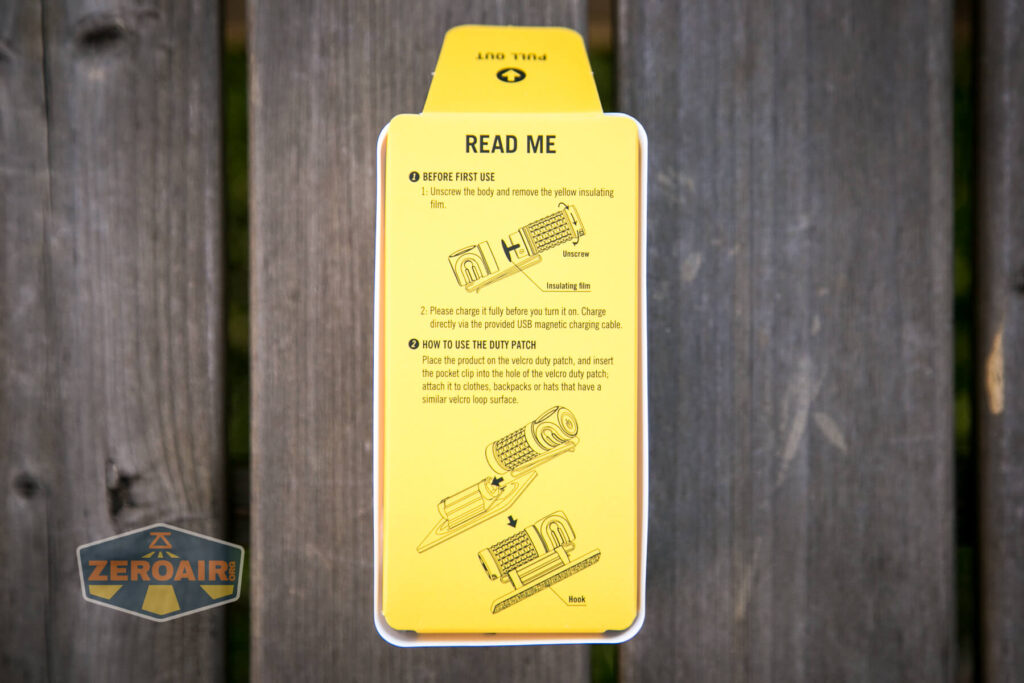
Here’s the test light with the venerable Convoy S2+. Mine’s a custom “baked” edition Nichia 219b triple. A very nice 18650 light.
And here’s the light beside my custom engraved TorchLAB BOSS 35, an 18350 light. I reviewed the aluminum version of that light in both 35 and 70 formats.


Retention and Carry
Since it ships attached to the light, let’s talk about the pocket clip first. It’s a black friction fit clip, which has the typical Olight connection. I like this because it means the light is in a reliable place in relation to the clip. Olight has added a little dot at the end of the arms to keep the clip from twisting off, too. Finally, the clip is a “both ways” clip, which I normally don’t like at all. The “primary” way to use the clip works well (that is, clipping with pants nearest the body of the light) but the second way is less ideal.
This clip would allow attachment to the bill of a cap, though this being a right angle light means that won’t be that ideal.


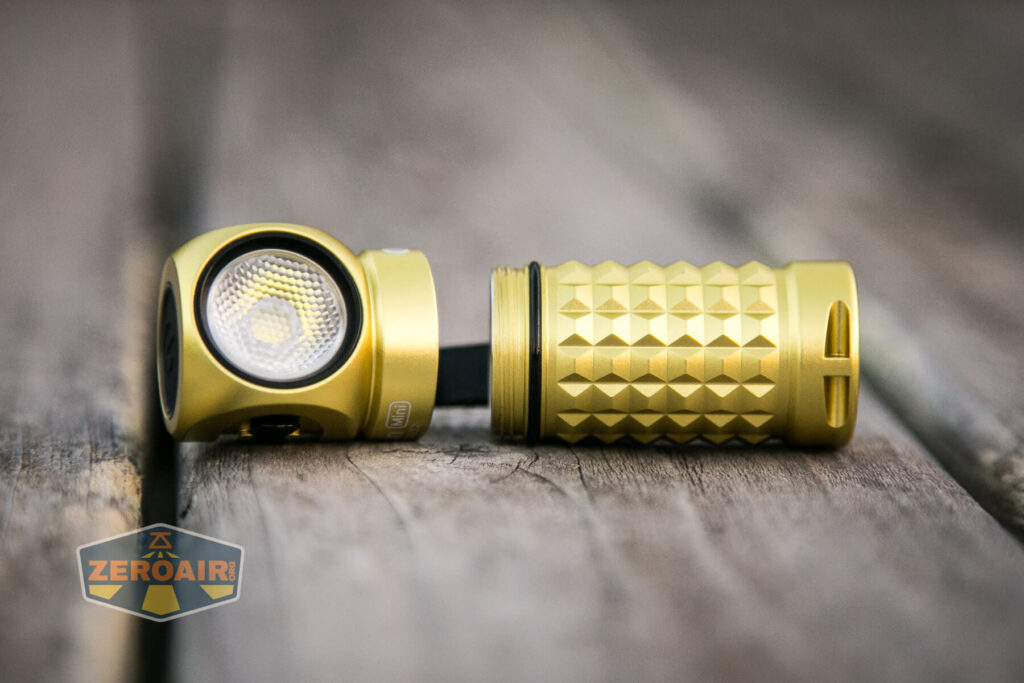
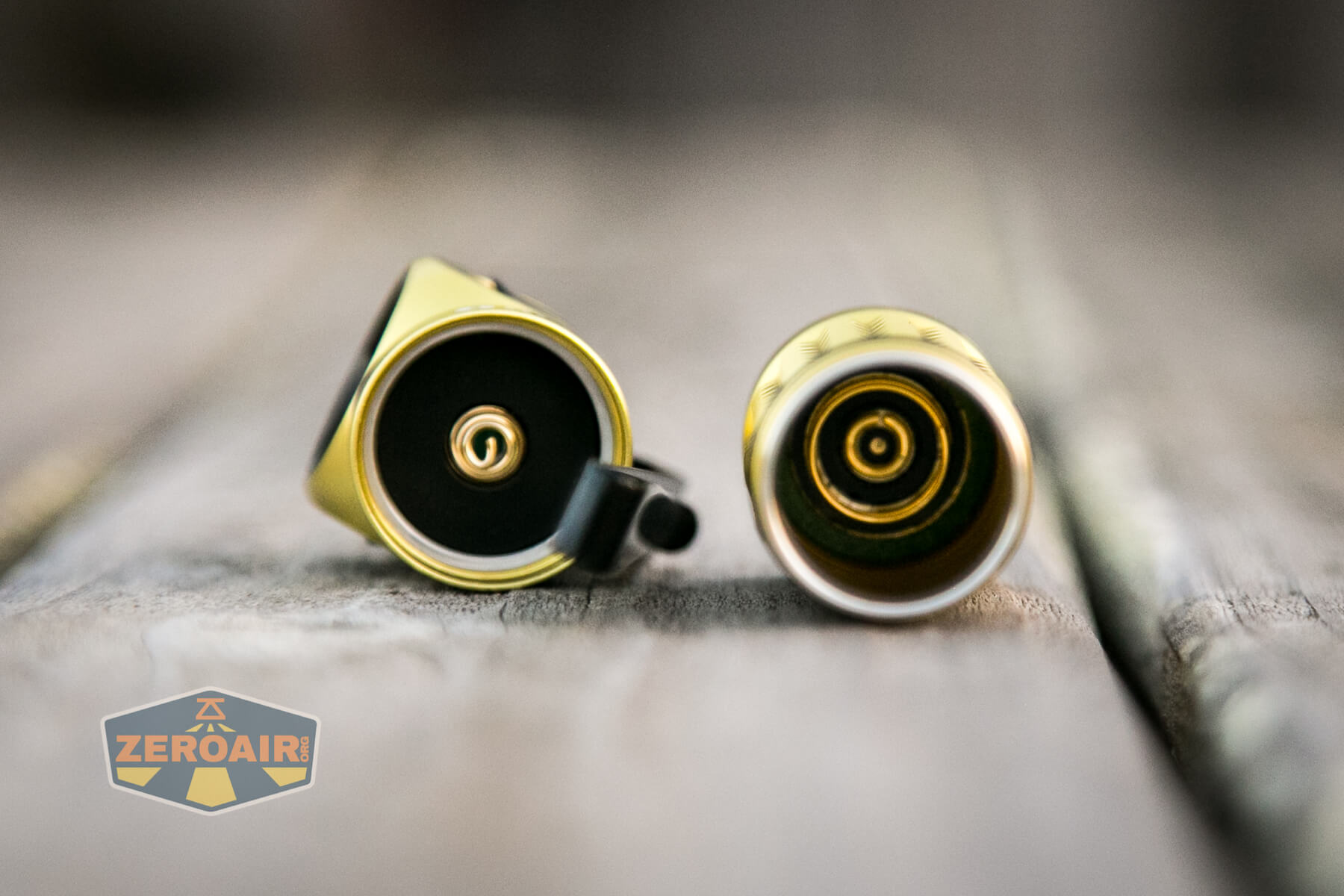
The manual states a 60-degree rotation, and that looks about right. I haven’t calibrated my eye-protractor in a while though.


This is a very simple headband. Just the around the head part, and just around one inch thick.

Also very adjustable.
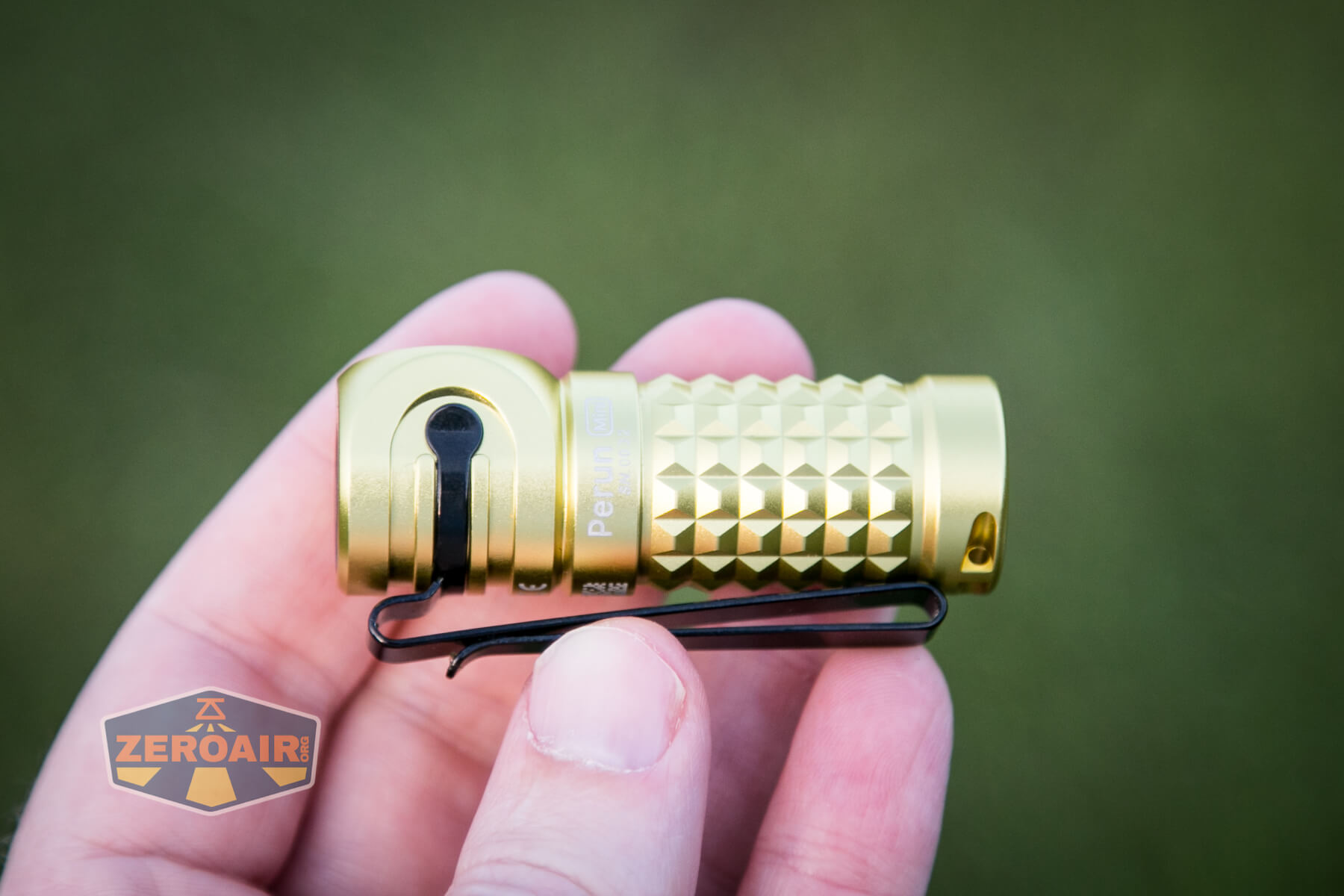
The loop portion of the velcro is on the headband. It’s around 4 inches long.
The real thing with this setup is that the hook of the patch is what can potentially contact your forehead. If you push the light around to adjust it, you’ll definitely feel that hook. Does it work though? Sure, it’s effective.

The magnet in the tailcap for charging also holds the light fairly reliably, too.
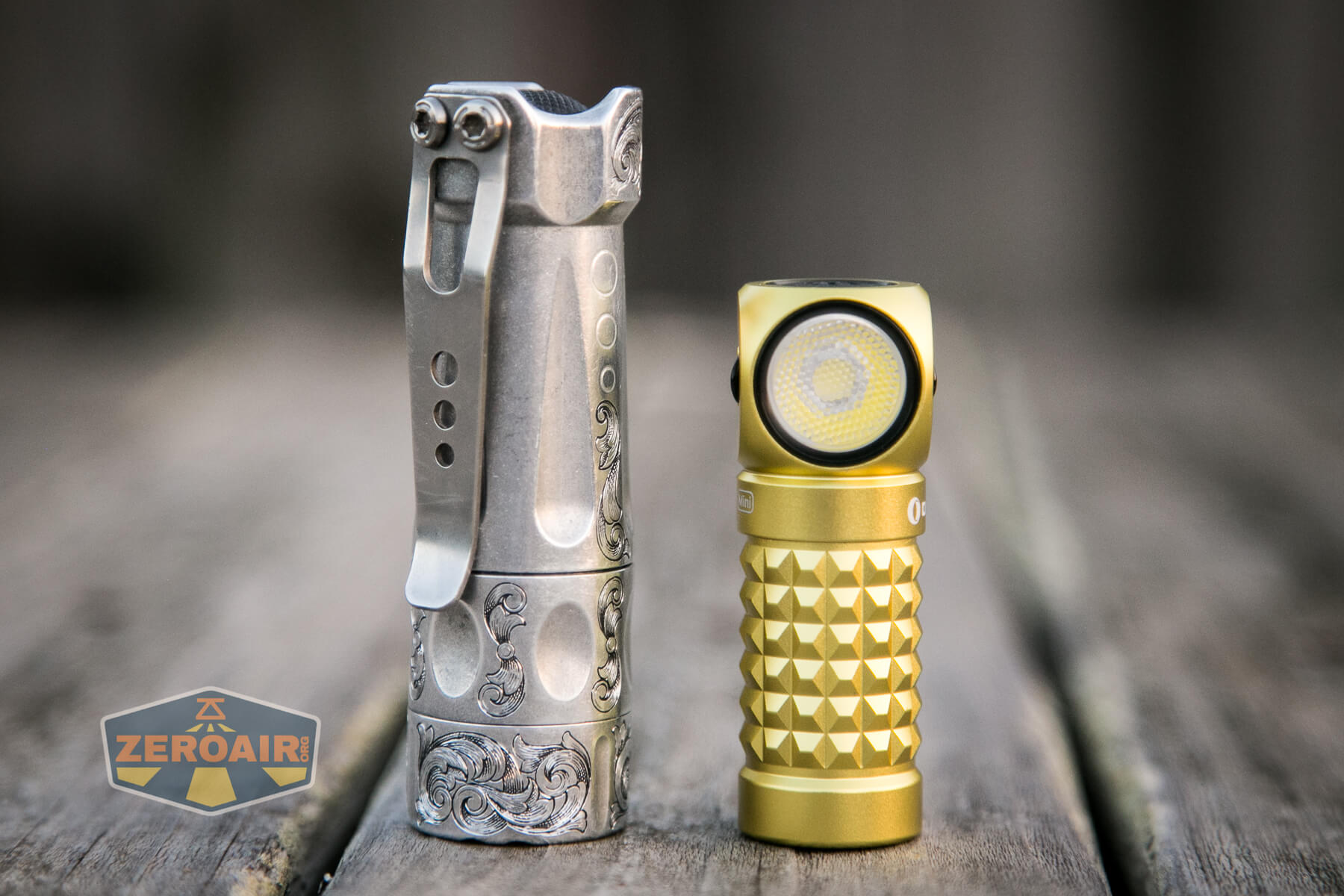
A final option for carrying is the included lanyard, which connects through the hole in the tailcap.
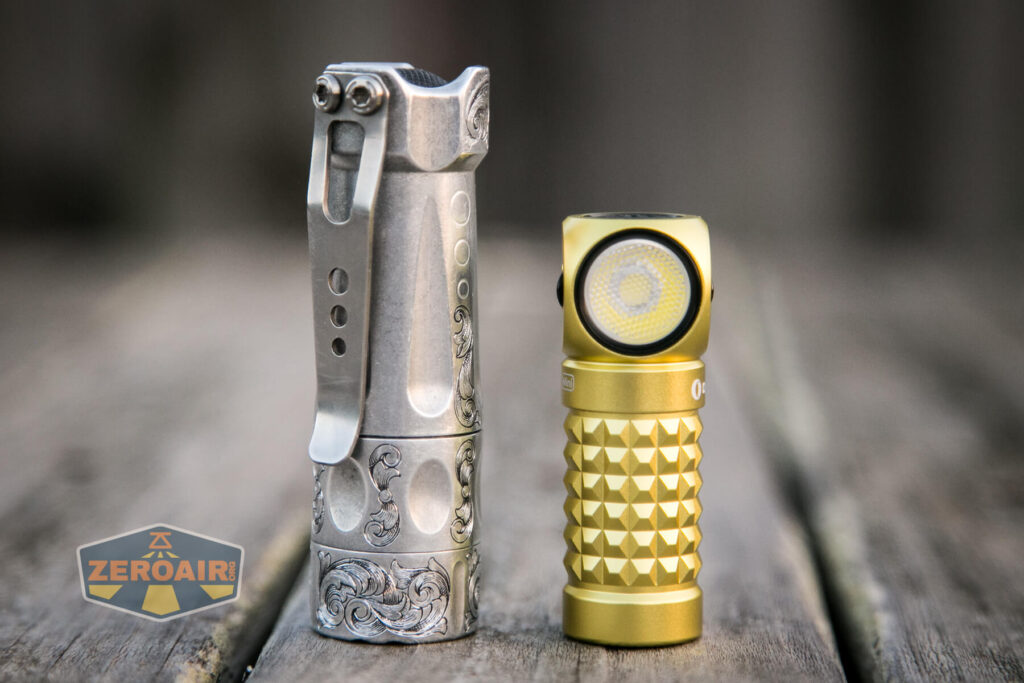
Power and Runtime
Olight includes the cell required for the Olight Perun Mini Kit Headlight. It’s a “customized” 16340, with a claimed 550mAh. “Customized” in this case means the positive is in the usual place, but there’s a ring of negative surrounding that.
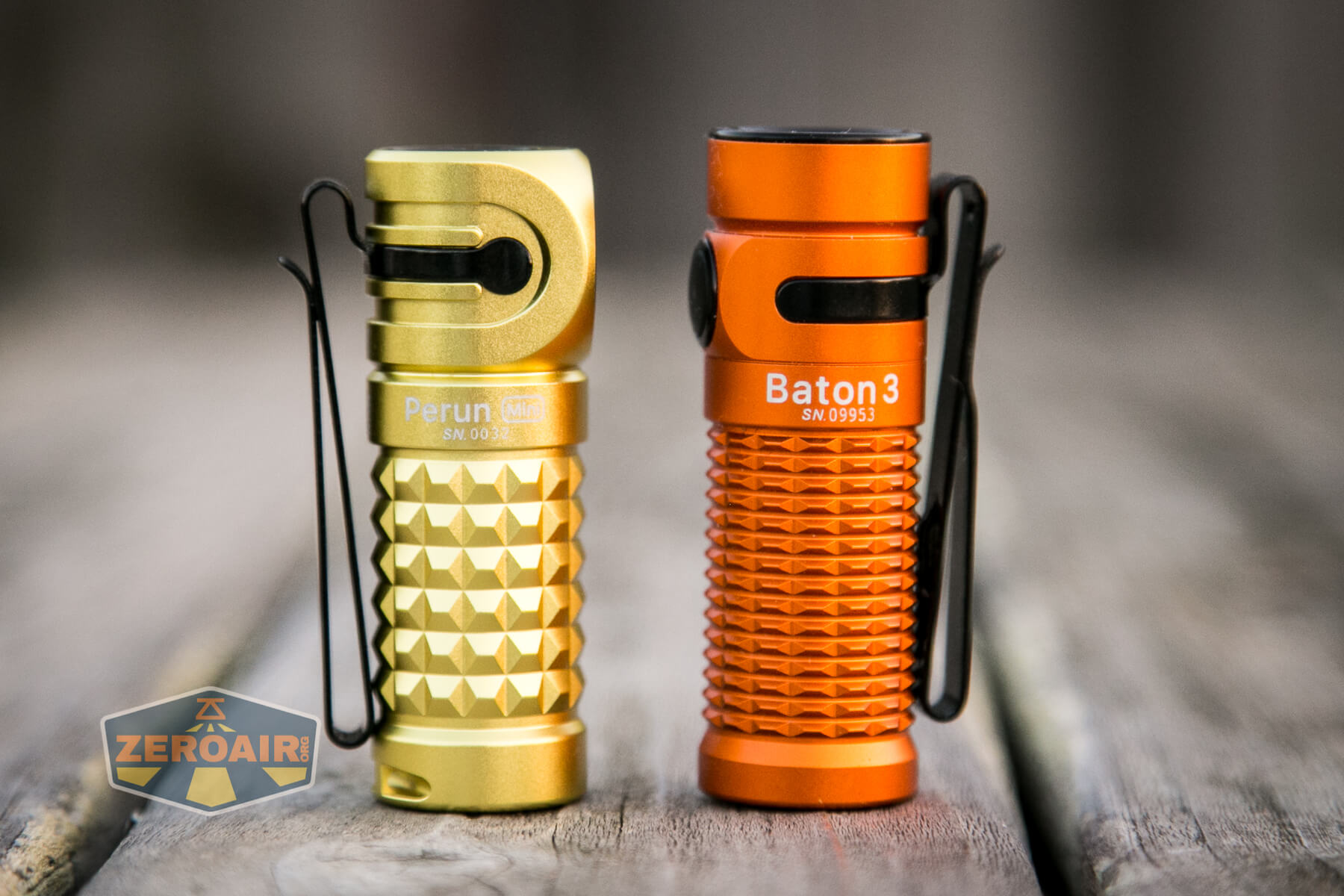
Below see both ends of the cell. The negative end is normal.
All this does mean that non-customized 16340 cells will not charge in the Perun Mini. However, conveniently, non-proprietary 16340 cells will operate fully on all modes.

The cell does not go into the Olight Perun Mini Kit Headlight in the “normal” way. In this light, you should put the end with the positive terminal away from the head.
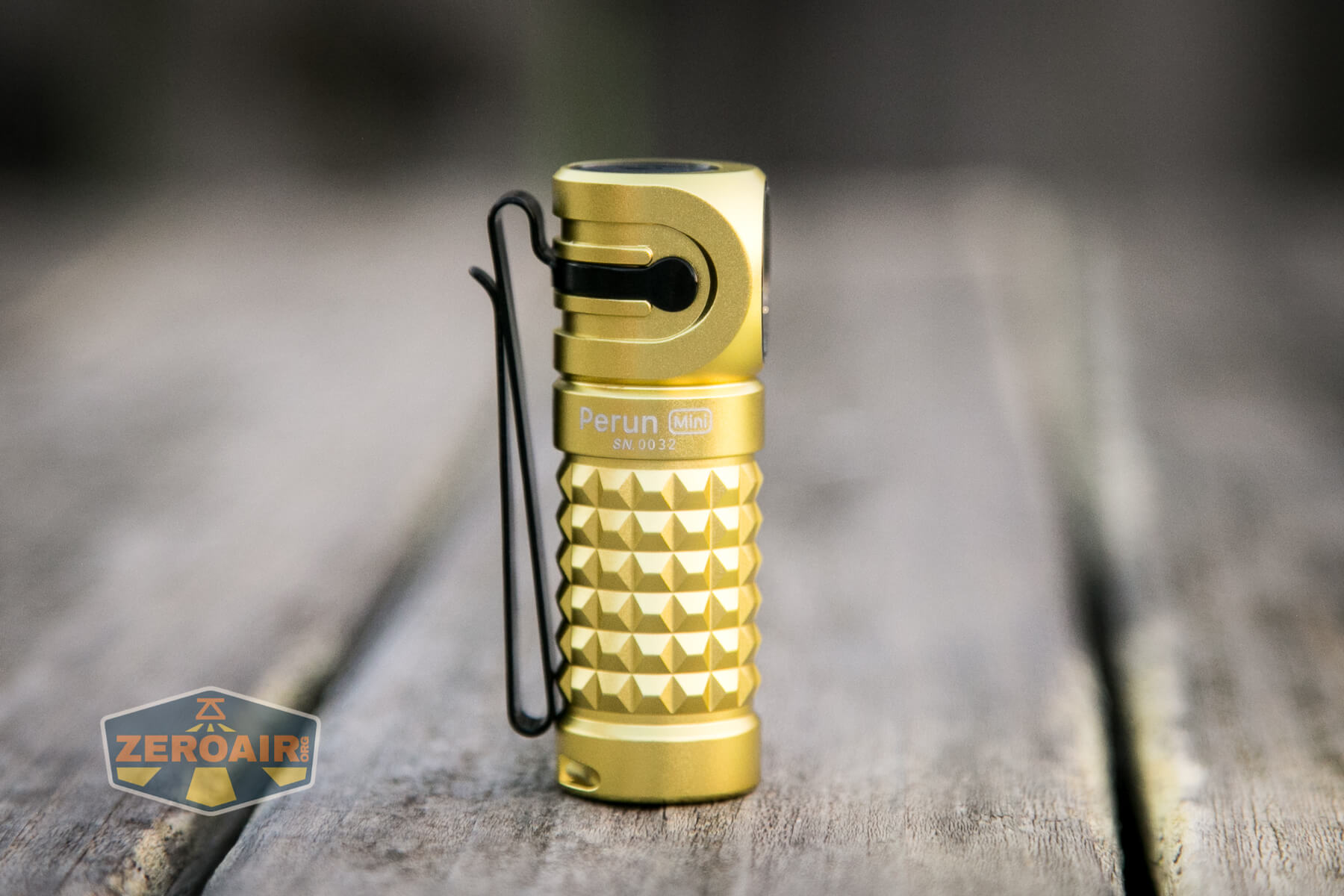
Here are a couple of runtimes.



Low voltage protection was observed in all tests.
Charging
The light has built-in charging as well. Included is a cable – USB to magnetic connector. This one is the “MCC 1A” and that’s important since there are many versions that look just about the same.

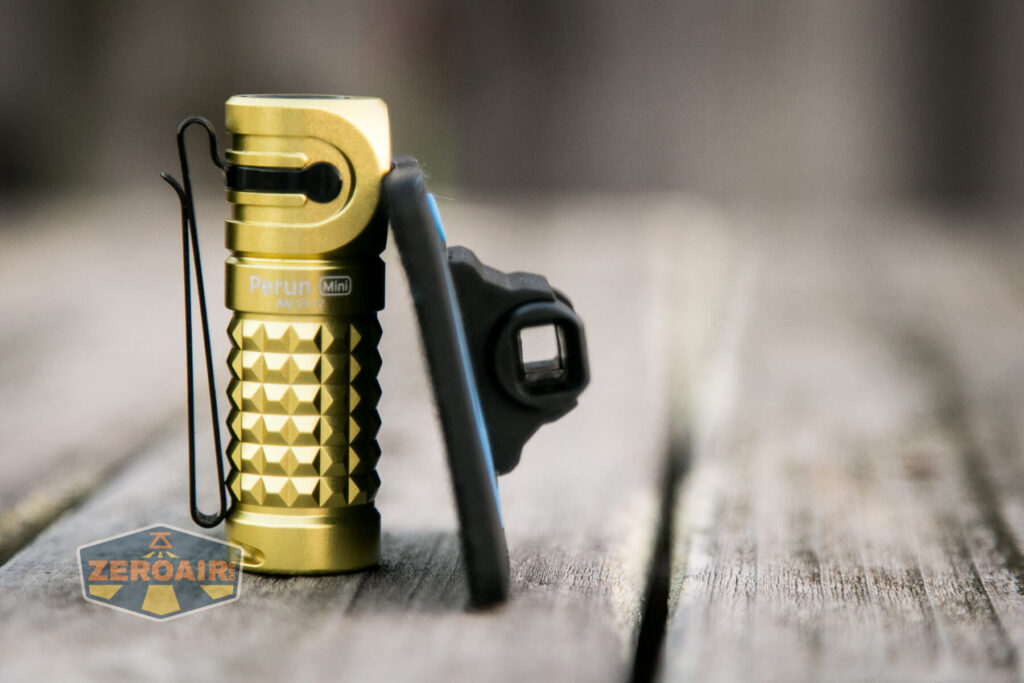
The charger snaps very cleanly to the light, and the light will sit upright on the base, too.

Here’s a charge graph. Charging is good, and well over 1C.

The charge indicator on the MCC 1A charger is red while charging but turns green …. sometime. It’s not specifically when charging is “complete” but it’s sometime around that. My experience with charging leads me to believe that the indicator turns green when the cell is “full enough” but probably not at 4.20V.
Modes and Currents
Mode Mode Claimed Output (lm) Claimed Runtime Measured Lumens Tailcap Amps Turbo 1000/250 1m/1h25m 1004 2.22 High 250 1h38m 241 0.37 Medium 65 6h 53 0.08 Low 15 25h 15 0.02 Moon 2 4.5d 2 0.00
Pulse Width Modulation
No PWM on any mode. Yay!
For reference, here’s a baseline shot, with all the room lights off and almost nothing hitting the sensor. Also, here’s the light with the worst PWM I could find. I’m adding multiple timescales, so it’ll be easier to compare to the test light. Unfortunately, the PWM on this light is so bad that it doesn’t even work with my normal scale, with is 50 microseconds (50us). 10ms. 5ms. 2ms. 1ms. 0.5ms. 0.2ms. In a display faster than 0.2ms or so, the on/off cycle is more than one screen, so it’d just (very incorrectly) look like a flat line. I wrote more about this Ultrafire WF-602C flashlight and explained a little about PWM too.
User Interface and Operation
The Olight Perun Mini Kit Headlight uses a single e-switch on the head. It’s a big flat switch, and nice and soft. It is not the least bit proud, which allows the light to headstand. The Perun Mini is perfectly vertical when headstanding, too.

The switch is also just the least bit clicky. If your attack angle is exactly straight down, you’ll feel it. But if you are off-axis even a little, you’ll wonder if you’re pressing it right, and you might have to fiddle with it a bit.

Here’s a UI table!
State Action Result Off Click On (Mode Memory, Moon, LMH only) Off Hold Moon Any Double Click Turbo On Hold Mode advance (Moon, LMH only) Turbo Double Click Exit Turbo to the previous mode (except if previous was high, then results in Medium) Any Triple Click SOS SOS Click Off On Click Off On Click and Hold (quickly)^ Timer (Single blink: 3 minutes, Double blink: 9 minutes) Timer Click and Hold (quickly)^ Switch between 3 and 9-minute timers. Off Hold (>2s) Lockout Lockout Hold (~2s) Unlock (and goes to Moonlight)
^ The manual states this as “Double click and hold” but I think it should be “click and hold” quickly. Any form of double click ends in Turbo or Strobe. The manual hasn’t been corrected yet, after all these years of this model.
LED and Beam
The emitter in this light is unspecified. That bothers me more than it probably should, but really how simple is it to just state the emitter. I reached out to Olight and at the time of this release, they have still not commented with an update.
I believe the emitter used in this Perun Mini is an Osram P9. It’s stated as CW, at least.
There’s a dimpled TIR, which gives a very smooth roll-off throughout the beam.


LED Color Report (CRI and CCT)
Beamshots
These beamshots are always with the following settings: f8, ISO100, 0.3s shutter, and manual 5000K exposure.
Tint vs BLF-348 (KillzoneFlashlights.com 219b version) (affiliate link)
I keep the test flashlight on the left, and the BLF-348 reference flashlight on the right.
I compare everything to the KillzoneFlashlights.com 219b BLF-348 because it’s inexpensive and has the best tint!
Conclusion
What I like
- Complete package
- Onboard charging looks good
- Small
- Hits specifications
- Can headstand (on switch end)
What I don’t like
- Unspecified emitter!
- Velcro patch has hooks that touch the skin
Buy the Olight Perun Mini Golden Yellow Kit Headlight at OlightStore.com!!
Notes
- This light was provided by Olight for review. I was not paid to write this review.
- This content originally appeared at zeroair.org. Please visit there for the best experience!
- For flashlight-related patches, stickers, and gear, head over to PhotonPhreaks.com!
- Use my amazon.com referral link if you’re willing to help support making more reviews like this one!
- Please support me on Patreon! Feeding flashlights is expensive! And funding Fun Fund Friday even more so. I deeply appreciate your support!







